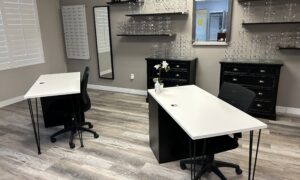By Ken Krivacic, OD, MBA
Track and manage your occupancy costs effectively: You can save money and invest it in areas that provide greater long-term yield.
When you think about the additional products and services you would like to offer patients, and the practice improvements you have in mind such as adding additional instrumentation, you first must consider facility, or occupancy, expenses. If you don’t have those expenses under control, your other plans have little hope of being realized. Occupancy expenses are defined as any cost related to the maintaining of a structure needed to run an optometric practice.
Rent comprises the largest bulk of the occupancy expense category. Below is a list of expenses incurred as a result of occupying a space:
- -Rent
- -Office maintenance
- -Management fees
- -Buildingoffice repairs
- -Buildingoffice security
- -Janitorial services
- -Utilities
Occupancy Cost Should Compromise No More than 5-8% of Total Budget
It is important to budget for all expenditures in an office. Occupancy expenses rank lower on the list of expenses in an optometric office than the big three of Cost of Goods, Staff and Net. Yet if one category is out of line it will affect the others. Most notably this tends to fall to the bottom line and eat into net profit.
According to optometric management consultant Jerry Hayes, OD, the recommended range of expenses related to occupancy cost should range from 5-8 percent of total income. The Essilor-sponsored Management & Business Academy reports the range at 6 percent to 8.5 percent. Interestingly, the larger grossing practices have a smaller occupancy cost than the smaller grossing practices.

Although the numbers above do not indicate the number of doctors employed per practice size, nor the years in practice, several things can be inferred from the numbers. Obviously, larger grossing practices make more efficient use of space. This could be largely attributed to multiple doctors in a single site requiring less space per doctor than a single practitioner. Also multiple doctors can gross more in the same space by varying schedules such as an early shift versus a late shift. Efficiencies of scale can also come into play as multiple doctors do not require a redundancy in staff and therefore require relatively less space. Examples of this are found in positions such as office manager, bookkeeper, insurance clerk, contact lens tech and lab tech. A multi-doctor office usually requires no more than one person in these positions, and therefore, less relative space is required.
In general, occupancy falls into a portion of spending considered fixed-cost (cost does not change relative to increases or decreases in revenue). Therefore, the larger a practice income, the relatively smaller percentage that fixed-cost will consume.
By the Numbers:
Multiple Doctors = Space Efficiency
A table on the MBA site, sponsored by Essilor, demonstrates space efficiency with multiple doctors. A practice with two or more ODs that grosses under $750,000 occupies 1,950 square feet on average. For a practice grossing twice that ($1.5 million), the average office space is only about a third bigger (3,000 square feet) on average.
Start Occupancy Budgeting at Beginning of Year
The process for us starts at the beginning of the year. I start with the budget from the previous year and project based on what I feel we can grow for the coming year. Since we are a longstanding office (30+ years) and rather large (close to $2.5 million in revenue in 2012) I estimate our growth rather conservatively at 3 percent per year. This estimate is plugged into an Excel spreadsheet and the projected numbers are used to establish our budget for the upcoming year. This will vary office-to-office depending on length in business and size of practice. Younger and smaller offices will have more room to grow and estimates can be ratcheted up. You may also want to factor in local and national economic outlooks, although, personally, I tend to focus more on the capability of the office to determine what growth can be.
After the budget is established, I share it with not only the office manager but the entire staff. We have a bi-annual company retreat designed for this purpose so that everyone is onboard and working for the same goal.
Use Yearly Time Frame
The time frame for this budget is yearly. Most companies have a yearly plan and we tend to follow that guideline. From there we track the budget monthly to ensure we stay on course.
In the occupancy expense category we can use the budget to determine if we need to expand our office space. If the percentage in that category is low and you are contemplating expanding, the numbers would indicate that can be done without too much worry about taking too much space. We have used the percentage in this category to help us reach a decision on office expansion or relocation in the past and it has always proven to be accurate.
Leave Flexibility in Budgeting
I feel you have to start with a budget somewhere. After all, a budget is only a projection of what you want to happen or what you expect to happen. It is not an exact science. Nobody can predict the future and there are many situations that occur throughout a year that can throw you off course. The only thing you know for certain is how you performed last year and this naturally would be your starting point for the next year. You may want to alter the budget slightly based on things you think may happen such as adding another doctor, expanding your space, etc. I would caution not to try to predict too much initially. It is far easier to amend the budget as you proceed through the year, but also keep your original projections as a barometer.
Develop Your Occupancy Budgeting Formula
We try to keep ours simple by just trying to keep our occupancy expenses between 5 percent to 8 percent of total income. We have used this projection for years and it is a reasonable number to expect for most optometric practices. As mentioned earlier, optometric consultant Jerry Hayes recommends between 5 percent to 8 percent. The Essilor-sponsored MBA program mentions a range from its members of between 6 percent to 8.5 percent. These numbers can vary depending on the size and age of the practice.
The occupancy cost category is one that remains fairly constant from year to year. Most of the cost in this category is consumed by rent. If you are like most practices, rent does not vary much month-to-month. In fact, if you have a long-term lease (generally five years or longer), the monthly rent usually only changes at the end of each year. The month-to-month rent usually remains constant over the course of a year. This makes budgeting for this category relatively simple. There can be some variability in the other portions of this category such as maintenance or utilities, yet these variables are generally small and have little impact on the overall percentage this category represents in the total budget.
Another thing to consider in this category is the decision on whether to rent office space or own your own building. We went through that exercise three years ago, and with the help of our budget and our accountant, arrived at the decision to purchase a building. At the time, as our business grew, we were running out of room in our previous space. Our budget told us we could expand and still stay within budget. It also told us we could purchase a building and still stay within budget. For us the decision was easy. I intended to practice at least another ten to fifteen years, about the time it would take to pay off the building. The new monthly “rent” would keep us on budget. By growing equity in a building, you are in fact paying yourself back in the occupancy cost category. In the long-term this investment turns the occupancy expense category into a net back to the owner.
Effective Occupancy Budgeting: Action Plan
Create an occupancy budget–and write it down. Too many practices go through the year without a plan or guideline and then only react when things go bad. You should have a budget and you should write it down.
Use the occupancy budget to help you determine if you can expand or relocate. The answer can be found in the numbers.
Consider purchasing a space rather than renting. If you don’t plan to move or relocate for years, this can turn an expense into an asset. If you do make this move, be sure to set up a separate company to purchase the space and rent out to the optometric practice.
Monitor your budget monthly. Letting things slip can either lead to more apathy and slippage or cause larger problems in the future. Monitoring monthly can also help you recognize trends.
Think long-term. This is more of a large ticket item with less variability month-to-month than purchasing frames would be.
Related ROB Articles
Track Your Staffing Costs: A Key to Practice Profitability
Track Your COG: Manage Well for Profitability
End-of-Year: Assess Finances and Plan for a Profitable New Year
Ken Krivacic, OD, is the owner of Las Colinas Vision Center in Irving, Texas. To contact him: kkrivacic@aol.com.



























